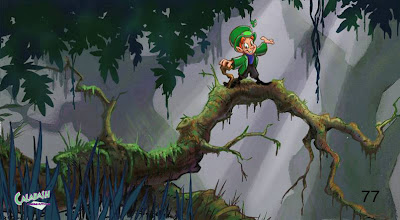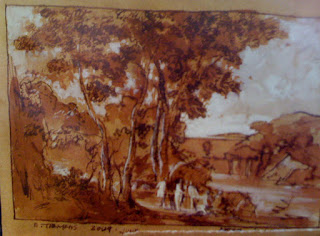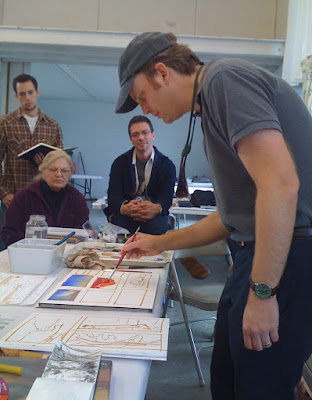These are all for the Learning Company's, "Strawberry Shortcake", "Reader Rabbit" or "Katie Kadet" cd rom series, painted around 2002, I believe, all in Photoshop.






















 I spent a good deal of time coming up wtih the palette and lighting in order to suggest a dark and mysterious forest, but not too scary. I thought that if I used a somewhat saturated purple in the shadows, the color would have the duel effect of being a shadow and suggesting magic. I also thought the forest would look as though it were a 'deep' woods that does not get a lot of bright sun if I used an emerald green local color on the grassy areas instead of the typical sap green. Also, it was tempting to make the very distant areas dark to suggest darkness, however, I decided dark tones in the distance would make the woods look more frightening, so I kept those areas light and desaturated.
I spent a good deal of time coming up wtih the palette and lighting in order to suggest a dark and mysterious forest, but not too scary. I thought that if I used a somewhat saturated purple in the shadows, the color would have the duel effect of being a shadow and suggesting magic. I also thought the forest would look as though it were a 'deep' woods that does not get a lot of bright sun if I used an emerald green local color on the grassy areas instead of the typical sap green. Also, it was tempting to make the very distant areas dark to suggest darkness, however, I decided dark tones in the distance would make the woods look more frightening, so I kept those areas light and desaturated. 



 Although Erik Tiemens works in the film industry as a well established concept artist with a great deal of respect, apart from that field he is just a really damn good painter with a lot of interesting work. It is difficult not to be inspired by his enthusiasm for the craft and history of painting.
Although Erik Tiemens works in the film industry as a well established concept artist with a great deal of respect, apart from that field he is just a really damn good painter with a lot of interesting work. It is difficult not to be inspired by his enthusiasm for the craft and history of painting.



 I love the idea of sketching out in the field, 'gathering data' as he referred to it, taking those sketches and experiences back into the studio to come up with something entirely new: a composed impression based on what was learned from life. To pull this off well, a certain amount of craft and skill is involved that one must, in the end, feel as though the landscape has not been slavishly copied, but rather pulled from a well of knowledge and creativity. In the end, the artist must arrive feeling completely personally immersed in self expression. Isn't that what it's all about? I left the workshop and the beautiful town of Mendocino completely inspired and looking in a more complete direction for my own work. I highly recommend this workshop for any working illustrator or fine artist who simply loves to paint.
I love the idea of sketching out in the field, 'gathering data' as he referred to it, taking those sketches and experiences back into the studio to come up with something entirely new: a composed impression based on what was learned from life. To pull this off well, a certain amount of craft and skill is involved that one must, in the end, feel as though the landscape has not been slavishly copied, but rather pulled from a well of knowledge and creativity. In the end, the artist must arrive feeling completely personally immersed in self expression. Isn't that what it's all about? I left the workshop and the beautiful town of Mendocino completely inspired and looking in a more complete direction for my own work. I highly recommend this workshop for any working illustrator or fine artist who simply loves to paint.